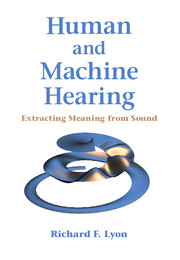Book contents
- Frontmatter
- Dedication
- Contents
- Foreword
- Preface
- Part I Sound Analysis and Representation Overview
- Part II Systems Theory for Hearing
- Part III The Auditory Periphery
- 13 Auditory Filter Models
- 14 Modeling the Cochlea
- 15 The CARFAC Digital Cochlear Model
- 16 The Cascade of Asymmetric Resonators
- 17 The Outer Hair Cell
- 18 The Inner Hair Cell
- 19 The AGC Loop Filter
- Part IV The Auditory Nervous System
- Part V Learning and Applications
- Bibliography
- Author Index
- Subject Index
- Plate section
15 - The CARFAC Digital Cochlear Model
from Part III - The Auditory Periphery
Published online by Cambridge University Press: 28 April 2017
- Frontmatter
- Dedication
- Contents
- Foreword
- Preface
- Part I Sound Analysis and Representation Overview
- Part II Systems Theory for Hearing
- Part III The Auditory Periphery
- 13 Auditory Filter Models
- 14 Modeling the Cochlea
- 15 The CARFAC Digital Cochlear Model
- 16 The Cascade of Asymmetric Resonators
- 17 The Outer Hair Cell
- 18 The Inner Hair Cell
- 19 The AGC Loop Filter
- Part IV The Auditory Nervous System
- Part V Learning and Applications
- Bibliography
- Author Index
- Subject Index
- Plate section
Summary
The modified transmission-line implementation, like the low-pass filter version, is an active system, with adjustments to the filter Q values changing the filter shapes and gains. … This functional variation of Q with level gives a nearly uniform 2.5:1 compression ratio in the cochlear output for inputs ranging from 0 to 100 dB SPL.
—“Accurate Tuning Curves In a Cochlear Model,” James Kates (1993a)The multiple-output cascade of asymmetric resonators with fast-acting compression (CARFAC) model of the auditory periphery combines concepts from many of the previous chapters, toward the primary goal of providing an efficient sound analyzer to support machine hearing applications.
An important secondary goal of CARFAC is to connect closely enough with known auditory physiology and psychophysics that it can be used to visualize and explain many interesting auditory phenomena. It is not a goal to be physically accurate, well calibrated, or in agreement with every detail of peripheral auditory processing, though it can be used as a starting point for those who have such goals.
Other than my own recent work (Lyon et al., 2010b; Lyon, 2010; Lyon et al., 2010a; Lyon, 2011b,a), the closest digital cochlear models in the literature to CARFAC are the variable-Q cascade–parallel models described by Kates (1993a), which also used cascades of asymmetric resonators specified by their poles and zeros; see the opening chapter quote above. The difference is that his stages include a second filter at each tap, and use a rather different pole–zero pattern, motivated by matching iso-rate neural tuning curves; ours is motivated by matching both psychophysical filters and physiological impulse responses, as discussed in Chapter 13.
Putting the Pieces Together
The CARFAC cochlear model pulls together the bits of knowledge that we surveyed in the previous nine chapters.
The coupled-form asymmetric resonators from Chapter 8 are combined into a filterbank with gammatone-like response as described in Chapter 9, using the cascade architecture motivated by Chapter 12.
- Type
- Chapter
- Information
- Human and Machine HearingExtracting Meaning from Sound, pp. 293 - 298Publisher: Cambridge University PressPrint publication year: 2017
- 3
- Cited by



